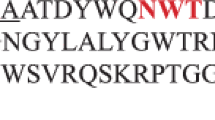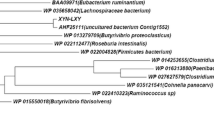Abstract
The DNA sequence for the xylanase gene fromPrevotella (Bacteroides) ruminicola 23 was determined. The xylanase gene encoded for a protein with a molecular weight of 65,740. An apparent leader sequence of 22 amino acids was observed. The promoter region for expression of the xylanase gene inBacteroides species was identified with a promoterless chloramphenicol acetyltransferase gene. A region of high amino acid homology was found with the proposed catalytic domain of endoglucanases from several organisms, includingButyrivibrio fibrisolvens, Ruminococcus flavefaciens, andClostridium thermocellum. The cloned xylanase was found to exhibit endoglucanase activity against carboxymethyl cellulose. Analysis of the codon usage for the xylanase gene found a bias towards G and C in the third position in 16 of 18 amino acids with degenerate codons.
Similar content being viewed by others
Literature Cited
Adams CW, Fornwald JA, Schmidt FJ, Rosenberg M, Brawner ME (1988) Gene organization and structure of theStreptomyces lividans gal operon. J Bacteriol 170:203–212
Anderson K, Salyers AA (1989) Biochemical evidence that starch breakdown byBacteroides thetaiotaomicron involves outer membrane starch-binding sites and periplasmic starchdegrading enzymes. J Bacteriol 171:3192–3198
Baird SD, Hefford MA, Johnson DA, Sung WL, Yaguchi M, Seligy VL (1990) The glu residue in the conserved asn-glupro sequence of two highly divergent endo-β-1,4-glucanases is essential for enzymatic activity. Biochem Biophys Res Commun 169:1035–1039
Bennetzen JL, Hall BD (1982) Codon usage in yeast. J Biol Chem 257:3026–3031
Berger E, Jones WA, Jones DT, Woods DR (1989) Cloning and sequencing of an endoglucanase (endl) gene fromButyrivibrio fibrisolvens H17c. Mol Gen Genet 219:193–198
Bradford MM (1976) A rapid and sensitive method for quantitation of microgram quantities of protein utillzing the principle of protein-dye binding. Anal Biochem 72:248–254
Brendel V, Hamm GH, Trifonov EN (1986) Terminators of transcription with RNA polymerase fromEscherichia coli: what they look like and how to find them. J Biomol Struct Dyn 3:705–723
Cram DS, Sherf BA, Libby RT, Mattalilano RJ, Ramachandran KL, Reeve RN (1987) Structure and expression of the genes formcrBDCGA, which encode the subunits of component C of methyl coenzyme M reductase inMethanococcus vannielii. Proc Natl Acad Sci USA 84:3992–3996
Cunningham C, McPherson CA, Martin J, Harris WJ, Flint HJ (1991) Sequence of a cellulase gene from the rumen anaerobeRuminococcus flavefaciens 17. Mol Gen Genet 228:320–323
Forsberg CW, Crosby B, Thomas DY (1986) Potential for manipulation of the rumen fermentation through the use of recombinant DNA techniques. J Anim Sci 63:310–325
Hall J, Hazlewood GP, Barker PJ, Gilbert HJ (1988) Conserved reiterated domains inClostridium thermocellum endoglucanases are not essential for catalytic activity. Gene 69:29–38
Hespell RB (1987) Biotechnology and modifications of the rumen microbial ecosystem. Proc Nutr Soc 46:407–413
Hespell RB, Wolf R, Bothast RJ (1987) Fermentation of xylans byButyrivibrio fibrisolvens and other ruminal bacteria. Appl Environ Microbiol 53:2849–2853
Horinouchi S, Furuya K, Nishiyama M, Suzuki H, Beppu T (1987) Nucleotide sequence of the streptothricin acetyltransferase gene fromStreptomyces lavendulae and its expression on heterologous hosts. J Bacteriol 169:1929–1937
Maniatis T, Fritsch EF, Sambrook J (1982) Molecular cloning: a laboratory manual. Cold Spring Harbor, New York: Cold Spring Harbor Laboratory Press
Mannarelli BM, Ericsson LD, Lee D, Stack RJ (1991) Taxonomic relationships among strains of the anaerobic bacteriumBacteroides ruminicola determined by DNA and extracellular polysaccharide analysis. Appl Environ Microbiol 57: 2975–2980
Matsushita O, Russell JB, Wilson DB (1990) Cloning and sequencing of aBacteroides ruminicola B14 endoglucanase gene. J Bacteriol 172:3620–3630
Nelson N (1944) A photometric adaptation of the Somogyi method for the determination of glucose. J Biol Chem 153:375–380
O'Bryan PJ, Hespell RB Unpublished data
Ogasowara N (1985) Markedly unbiased codon usage inBacillus subtilis. Gene 40:145–150
Perlman D, Halvorson HO (1983) A putative signal peptidase recognition site and sequence in eukaryotic and prokaryotic signal peptides. J Mol Biol 167:391–409
Shah HN, Collins DM (1990)Prevotella, a new genus to includeBacteroides melaninogenicus and related species formerly classified in the genusBacteroides. Int J Syst Bacteriol 40:205–208
Smith CJ (1991) Personal communication
Smith CJ, Hespell RB (1983) Prospects for development and use of recombinant deoxyribonucleic acid techniques with ruminal bacteria. J Dairy Sci 66:1536–1546
Smith CJ, Rogers MB, McKww ML (1992) Heterologous gene expression inBacteroides fragilis. Plasmid 27:141–154
Thompson CJ, Gray GS (1983) Nucleotide sequence of a streptomycete aminoglycoside phosphotransferase gene and its relationship to phosphotransferases encoded by resistance plasmids. Proc Natl Acad Sci USA 80:5190–5194
von Heijne G (1986) A new method for predicting signal sequences cleavage sites. Nucleic Acids Res 14:4683–4690
Weaver J, Whitehead TR, Cotta MA, Valentine PC, Salyers AA (1992) Genetic analysis of a locus on theBacteroides ovatus chromosome which contains xylan utilization genes. Appl Environ Microbiol 58:2764–2770
Whitehead TR, Hespell RB (1989) Cloning and expression inEscherichia coli of a xylanase gene fromBacteroides ruminicola 23. Appl Environ Microbiol 55:893–896
Whitehead TR, Hespell RB (1990a) The genes for three xylandegrading activities fromBacteroides ovatus are clustered in a 3.8-kilobase region. J Bacteriol 172:2408–2412
Whitehead TR, Hespell RB (1990b) Heterologous expression of theBacteroides ruminicola xylanase gene inBacteroides fragilis andBacteroides uniformis. FEMS Microbiol Lett 66:61–66
Whitehead TR, Lee DA (1991) Cloning and comparison of xylanase genes from ruminal and colonicBacteroides species. Curr Microbiol 23:15–19
Whitehead TR, Cotta MA, Hespell RB (1991) Introduction of theBacteroides ruminicola xylanase gene into theBacteroides thetaiotaomicron chromosome for production of xylanase activity. Appl Environ Microbiol 57:277–282
Zhang J, Deutscher MP (1992) A uridine-rich sequence required for translation of prokaryotic mRNA. Proc Natl Acad Sci USA 89:2605–2609
Author information
Authors and Affiliations
Additional information
This manuscript is dedicated to the memory of my father, William C. Whitehead, 1920–1992.
The mention of firm names or trade products does not imply that they are endorsed or recommended by the U.S. Department of Agriculture over other firms of similar products not mentioned.
Rights and permissions
About this article
Cite this article
Whitehead, T.R. Analyses of the gene and amino acid sequence of thePrevotella (bacteroides) ruminicola 23 xylanase reveals unexpected homology with endoglucanases from other genera of bacteria. Current Microbiology 27, 27–33 (1993). https://doi.org/10.1007/BF01576830
Issue Date:
DOI: https://doi.org/10.1007/BF01576830




